Attached files
| file | filename |
|---|---|
| 8-K - HEALTHSOUTH CORPORATION 8-K 03-08-2011 - Encompass Health Corp | form8k_03082011.htm |

Exhibit 99.1
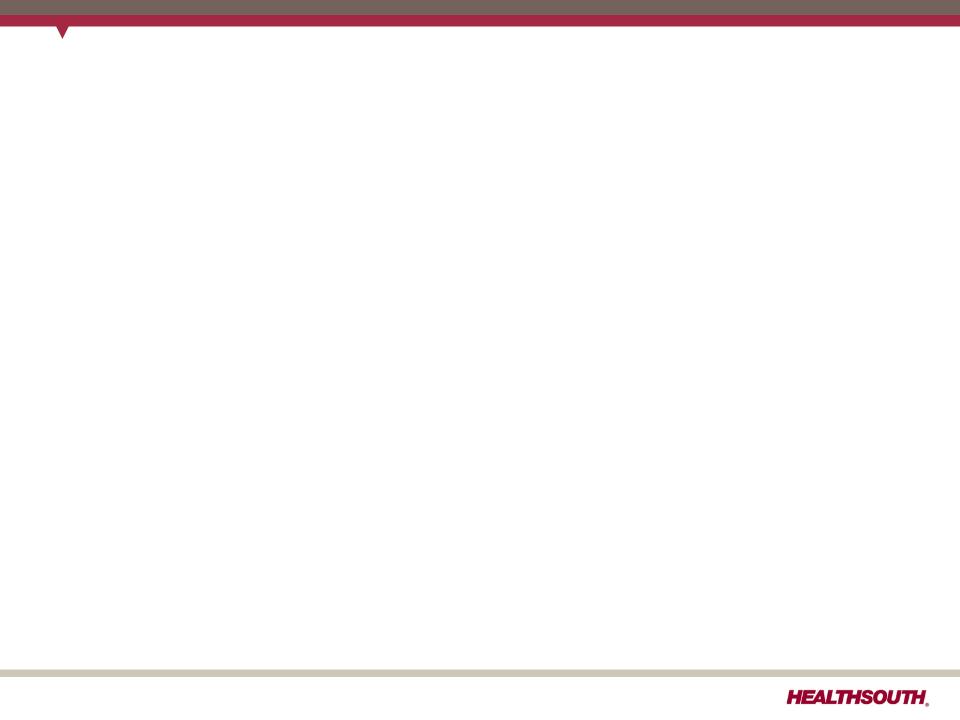
The information contained in this presentation includes certain estimates, projections and other forward-
looking information that reflect our current views with respect to future events, strategy, capital
expenditures and financial performance. These estimates, projections and other forward-looking
information are based on assumptions that HealthSouth believes, as of the date hereof, are reasonable.
Inevitably, there will be differences between such estimates and actual events or results, and those
differences may be material.
looking information that reflect our current views with respect to future events, strategy, capital
expenditures and financial performance. These estimates, projections and other forward-looking
information are based on assumptions that HealthSouth believes, as of the date hereof, are reasonable.
Inevitably, there will be differences between such estimates and actual events or results, and those
differences may be material.
There can be no assurance that any estimates, projections or forward-looking information will be realized.
All such estimates, projections and forward-looking information speak only as of the date hereof.
HealthSouth undertakes no duty to publicly update or revise the information contained herein.
HealthSouth undertakes no duty to publicly update or revise the information contained herein.
You are cautioned not to place undue reliance on the estimates, projections and other forward-looking
information in this presentation as they are based on current expectations and general assumptions and
are subject to various risks, uncertainties and other factors, including those set forth in the Form 10-K for the
year ended December 31, 2010, and in other documents we previously filed with the SEC, many of which
are beyond our control, that may cause actual events or results to differ materially from the views, beliefs
and estimates expressed herein.
information in this presentation as they are based on current expectations and general assumptions and
are subject to various risks, uncertainties and other factors, including those set forth in the Form 10-K for the
year ended December 31, 2010, and in other documents we previously filed with the SEC, many of which
are beyond our control, that may cause actual events or results to differ materially from the views, beliefs
and estimates expressed herein.
Note Regarding Presentation of Non-GAAP Financial Measures
The following presentation includes certain “non-GAAP financial measures” as defined in Regulation G
under the Securities Exchange Act of 1934. Schedules are attached that reconcile the non-GAAP financial
measures included in the following presentation to the most directly comparable financial measures
calculated and presented in accordance with Generally Accepted Accounting Principles in the United
States. Our Form 8-K, dated March 8, 2011, to which the following supplemental slides are attached as
Exhibit 99.1, provides further explanation and disclosure regarding our use of non-GAAP financial measures
and should be read in conjunction with these supplemental slides.
The following presentation includes certain “non-GAAP financial measures” as defined in Regulation G
under the Securities Exchange Act of 1934. Schedules are attached that reconcile the non-GAAP financial
measures included in the following presentation to the most directly comparable financial measures
calculated and presented in accordance with Generally Accepted Accounting Principles in the United
States. Our Form 8-K, dated March 8, 2011, to which the following supplemental slides are attached as
Exhibit 99.1, provides further explanation and disclosure regarding our use of non-GAAP financial measures
and should be read in conjunction with these supplemental slides.
Forward-Looking Statements
2
Exhibit 99.1

|
Inpatient Rehabilitation Hospitals (“IRF”)
|
|
|
Outpatient Rehabilitation Satellite Clinics
|
|
|
Long-Term Acute Care Hospitals (“LTCH”)
|
|
|
Hospital-Based Home Health Agencies
|
|
|
Employees
|
|
|
Revenue in 2010
|
|
|
Inpatient Discharges in 2010
|
|
|
Outpatient Visits in 2010
|
|
|
Number of States
|
|
|
Exchange (Symbol)
|
|
3
Largest Provider of Inpatient Rehabilitative Healthcare Services in the U.S.
Our Company
|
Marketshare
|
|
~ 8% of IRFs
~ 17% of Licensed Beds ~ 22% of Patients Served |
Exhibit 99.1
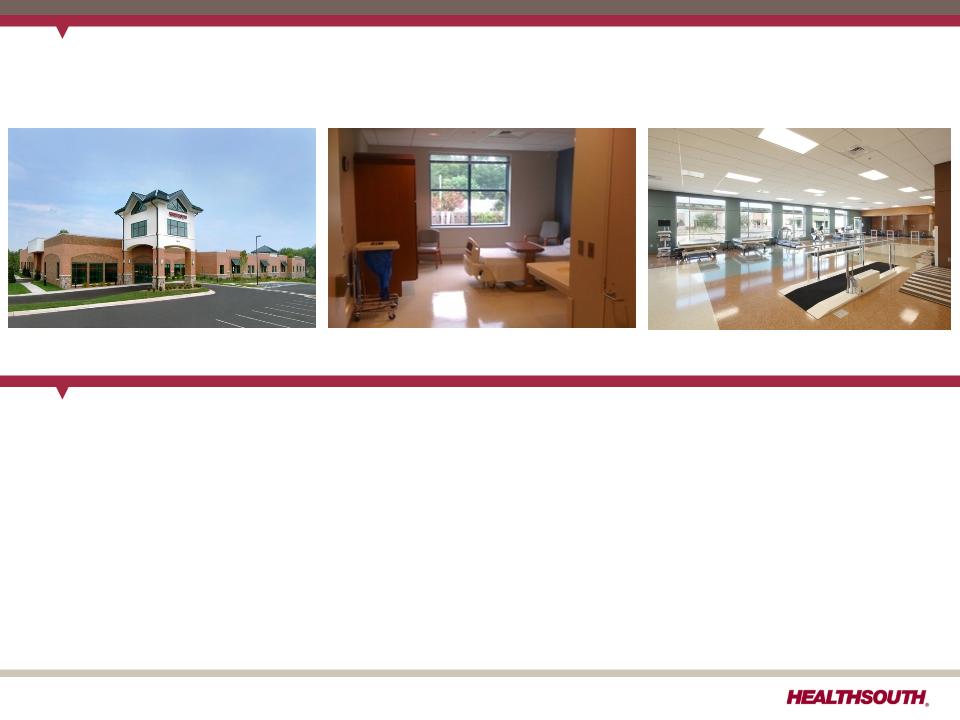
Our Hospitals
Major Services
• Rehabilitation Physicians: manage and treat medical needs of patients
• Rehabilitation Nurses: oversee treatment programs of patients
• Physical Therapists: address physical function, mobility, safety
• Occupational Therapists: promote independence and re-integration
• Speech-Language Therapists: treat communication & swallowing disorders
• Case Managers: coordinate care plan with physician, caregivers and family
• Post-discharge services: outpatient therapy and home health
4
Exhibit 99.1

Our Patients
5
Most Common Conditions (2010)
1. Stroke 17.2%
2. Neurological 15.2%
3. Debility 11.3%
4. Fracture of the lower extremity 11.0%
5. Knee/Hip replacement 9.5%
6. Other orthopedic conditions 9.5%
7. Brain injury 7.4%
8. Cardiac conditions 4.3%
9. Spinal cord injury 3.6%
10. All other 11.0%
Referral Sources
94% Acute Care Hospitals
5% Physician Offices
1% Skilled Nursing Facilities
Admission to an IRF
• Physicians and acute care
hospital case managers are key
decision-makers.
hospital case managers are key
decision-makers.
• All IRF patients must meet
reasonable and necessary criteria
and must be admitted by a
physician.
reasonable and necessary criteria
and must be admitted by a
physician.
• All IRF patients must be medically
stable and have potential to
tolerate three hours of therapy per
day (minimum).
stable and have potential to
tolerate three hours of therapy per
day (minimum).
• IRF patients receive 24-hour, 7
days a week nursing care.
days a week nursing care.
• Average length of stay (ALOS) =
14.1 days
14.1 days
Exhibit 99.1

Our Quality
FIM Gain
Change in
Functional
Independence
Measurement
(based on an 18
point assessment)
from admission to
discharge
Functional
Independence
Measurement
(based on an 18
point assessment)
from admission to
discharge
6
(1) Average = Expected, Risk-adjusted
• Inpatient rehabilitation hospitals evaluate all patients at admission and upon
discharge to determine their functional status.
discharge to determine their functional status.
− The Functional Independence Measurement (“FIM”) patient assessment
instrument is used for these evaluations.
instrument is used for these evaluations.
• The difference between the FIM scores at admission and upon discharge is called
the “FIM Gain.”
the “FIM Gain.”
− The greater the FIM Gain, the greater the patient’s level of independence, the
better the patient outcome.
better the patient outcome.
Exhibit 99.1

(1) The 1,171 total and the 91 for HLS do not include HealthSouth Rehabilitation Hospital of Northern Virginia; Rehabilitation Hospital of Southwest Virginia;
Rehabilitation Hospital of Mesa, AZ; and Rehabilitation Hospital of Fredericksburg, VA. that were opened after the data collection. Desert Canyon
Rehabilitation Hospital and HealthSouth Sugar Land Rehabilitation Hospital, currently owned by HLS, were included in the 139 non-HLS freestanding.
Rehabilitation Hospital of Mesa, AZ; and Rehabilitation Hospital of Fredericksburg, VA. that were opened after the data collection. Desert Canyon
Rehabilitation Hospital and HealthSouth Sugar Land Rehabilitation Hospital, currently owned by HLS, were included in the 139 non-HLS freestanding.
(2) In 2009, HealthSouth averaged 1,177 total Medicare and non-Medicare discharges in its 90 consolidated hospitals and 6 long-term acute care hospitals.
Sources: FY 2011 CMS Rate Setting File - see slide 28
7
Total Inpatient Rehabilitation Facilities (IRFs): 1,171 (1)
Our Cost-Effectiveness
HealthSouth
differentiates
itself by
providing
superior quality
care at a
differentiates
itself by
providing
superior quality
care at a
lower cost.
Exhibit 99.1

Our Payors (2010)
Prospective Payment System (“PPS”)
• Payments based on Case Mix Groups
(“CMGs”)
(“CMGs”)
– Diagnosis of patient’s illness
• Fixed payment per CMG adjusted for:
– Acuity/severity
– Regional wage differential
• Per diems for “short stays”
Per Diem or CMG
• Negotiated rate
• Some are “tiered” for acuity/severity
Variety of methodologies
Varies by state
Variety of methodologies
Medicare
Managed Care
• Includes managed
Medicare
Medicare
Other Third-Party Payors
Medicaid
Workers’ Comp./
Patients/Other
Patients/Other
Payment Methodology
Payor Source
8
70.5%
21.5%
2.3%
4.0%
1.7%
Exhibit 99.1

Our Track Record
(1)Reconciliation to GAAP provided on slides 29 and 31-35.
9
Exhibit 99.1
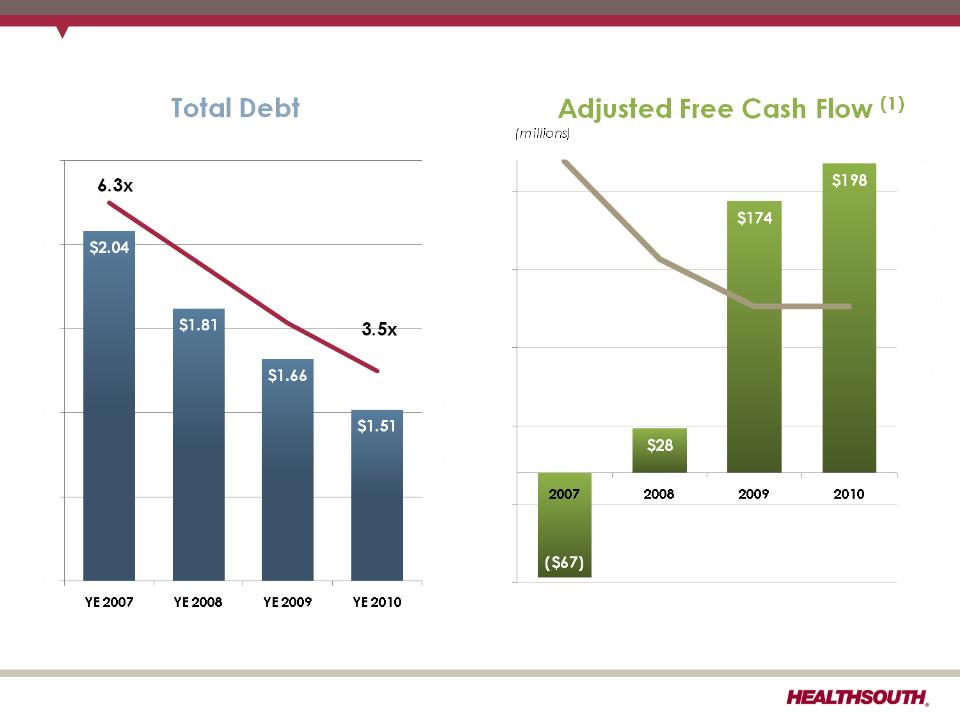
Historical Performance
10
Leverage Ratio(1)
(billions)
(1) Reconciliation to GAAP provided on slides 29-35.
Interest Expense
$229
$126
Exhibit 99.1

Business Outlook: 2011 to 2013
Business Model
• Adjusted EBITDA CAGR: 5-8% (1)
• Adjusted Free Cash Flow CAGR: 12-17% (1)
Strategy
2010
2011
2012
2013
Deleveraging(2)
Goal: < 4.0x
debt to EBITDA
debt to EBITDA
Longer-Term Goal: ~ 3.0x
debt to EBITDA (3.5x goal achieved at year-end 2010)
debt to EBITDA (3.5x goal achieved at year-end 2010)
Growth
Organic growth (includes capacity expansions)
De novos (~ 2-3/year)
IRF acquisitions (~ 2-3/year)
Opportunistic, disciplined acquisitions
of complementary post-acute services
of complementary post-acute services
Key Operational
Initiatives
Initiatives
• Beacon (Management Reporting Software) = Labor / outcomes / quality optimization
• TeamWorks = Care Management
• “CPR” (Comfort, Professionalism, Respect) Initiative
(1) Reconciliation to GAAP provided on slides 29-35.
(2) Exclusive of any E&Y recovery.
11
Exhibit 99.1
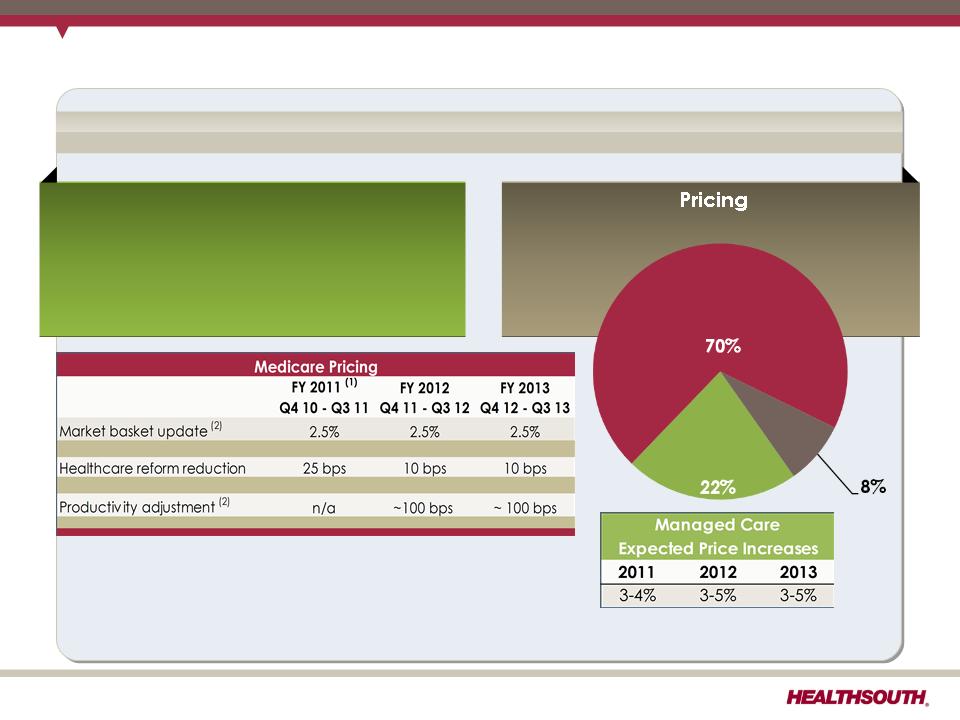
Business Outlook: Revenue Assumptions
12
Revenue
Volume
•2.5% to 3.5% annual growth (excludes
acquisitions)
acquisitions)
•Includes bed expansions, de novos
and unit consolidations
and unit consolidations
Medicare
Managed
Care
Care
Other
(1) We believe based on the 2011 Medicare rule for IRFs, HealthSouth should realize an increase of approximately 2.1% annually.
(2) Management estimates
Exhibit 99.1
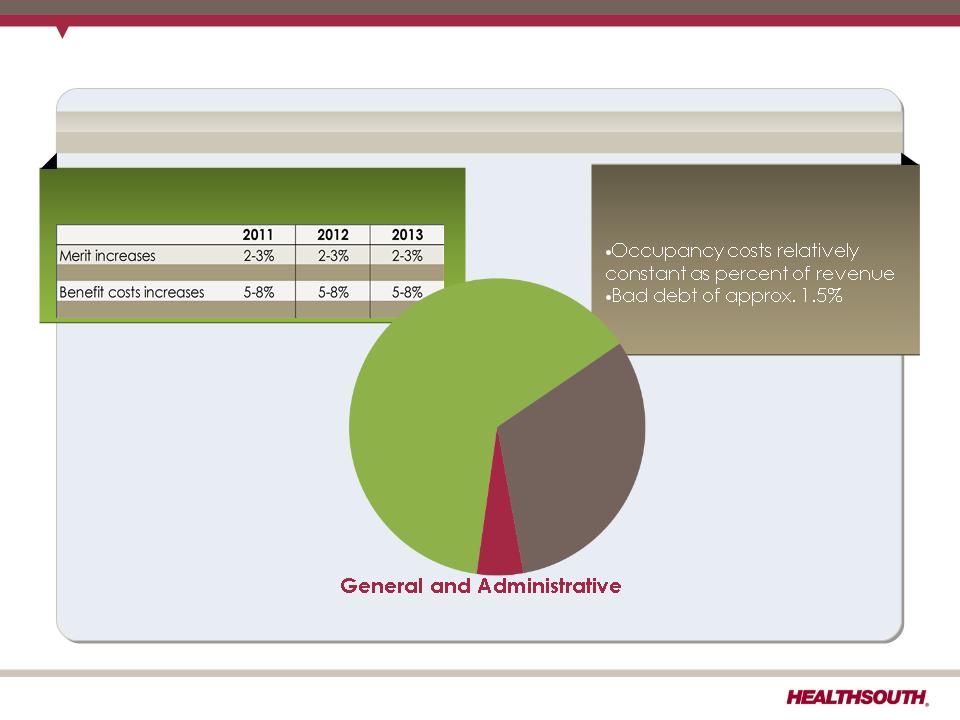
Business Outlook: Expense Assumptions
Expense
Salaries & Benefits (1)
Hospital Expenses
• Other operating and supplies
tracking with inflation
tracking with inflation
4.5% of revenue
(excludes stock-based compensation)
Salaries
& Benefits
Hospital
Expenses
Expenses
(1) Salaries, Wages and Benefits: 85% Salaries and Wages; 15% Benefits
13
Exhibit 99.1

Adjusted Free Cash Flow (1) Assumptions
(1) Reconciliation to GAAP provided on slide 30.
• Items that will affect Adjusted Free Cash Flow in 2011:
+ Cash settlements for interest rate swaps will be $33.8 million lower in 2011.
− Interest expense will be approximately $4 million per quarter higher in 2011 than 2010,
prior to any repayment/refinancing of the 10.75% senior notes.
prior to any repayment/refinancing of the 10.75% senior notes.
+ Interest expense will be reduced with any repayment/refinancing of 10.75% senior notes
callable in June 2011.
callable in June 2011.
– Maintenance capital expenditures are estimated to be approximately $20 million higher
in 2011 than 2010.
in 2011 than 2010.
• 2010 working capital benefited from a shift in timing of interest payments related to the
refinancing in Q4 2010, offset by the $6.9 million unwind fee related to the termination of
the two forward-starting interest rate swaps.
refinancing in Q4 2010, offset by the $6.9 million unwind fee related to the termination of
the two forward-starting interest rate swaps.
HealthSouth’s GAAP income statement will be affected by a
number of items that will not affect cash flow from operating
activities or adjusted free cash flow:
number of items that will not affect cash flow from operating
activities or adjusted free cash flow:
•Normalized GAAP tax rate resulting from the valuation
allowance reversal in Q4 2010.
allowance reversal in Q4 2010.
•Loss on early extinguishment of debt
Multi-Year Adjusted Free Cash Flow 12% to 17% CAGR
14
Exhibit 99.1

Free Cash Flow Reinvestment
15
• $500 million of 10.75% notes callable June 2011
• Growth in core business
• Bed expansions
• Hospital acquisitions
• Acute care IRF unit acquisition/consolidation
• De novo hospitals
• Lower capital cost
• Share repurchase
• Offset shares underlying convertible preferred
shares
shares
• Offset shares issued in settlement of securities
litigation
litigation
Adjusted free cash flow CAGR: 12-17%
• Acquisitions of complementary business
Exhibit 99.1
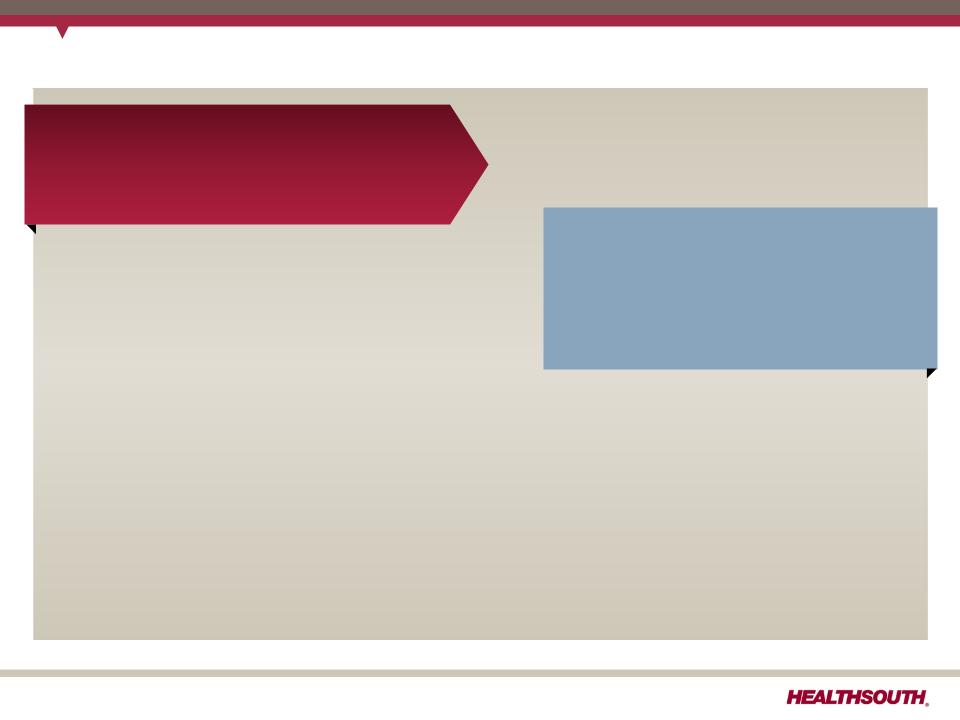
2011 Guidance - Adjusted EBITDA
Adjusted EBITDA (1)
$440 million to $450 million
(1) Reconciliation to GAAP provided on slides 29 and 31-35.
Considerations:
ü2010 bad debt expense was 0.9% of revenue; expect 2011 bad debt expense to
be approximately 1.5% of revenue, in line with historical average
be approximately 1.5% of revenue, in line with historical average
üMedicare pricing in Q4 2011 will be reduced by a TBD productivity adjustment,
which we estimate to be 100 basis points.
which we estimate to be 100 basis points.
üOutpatient revenues subject to approximately $1.4 million reduction related to
the 25% rate reduction for reimbursement of therapy expenses for multiple therapy
services (Medicare physician fee schedule for calendar year 2011CMS).
the 25% rate reduction for reimbursement of therapy expenses for multiple therapy
services (Medicare physician fee schedule for calendar year 2011CMS).
Reflects:
• 2.9% to 5.3% growth over 2010
• 7.2% to 8.4% CAGR over 2009
16
Exhibit 99.1
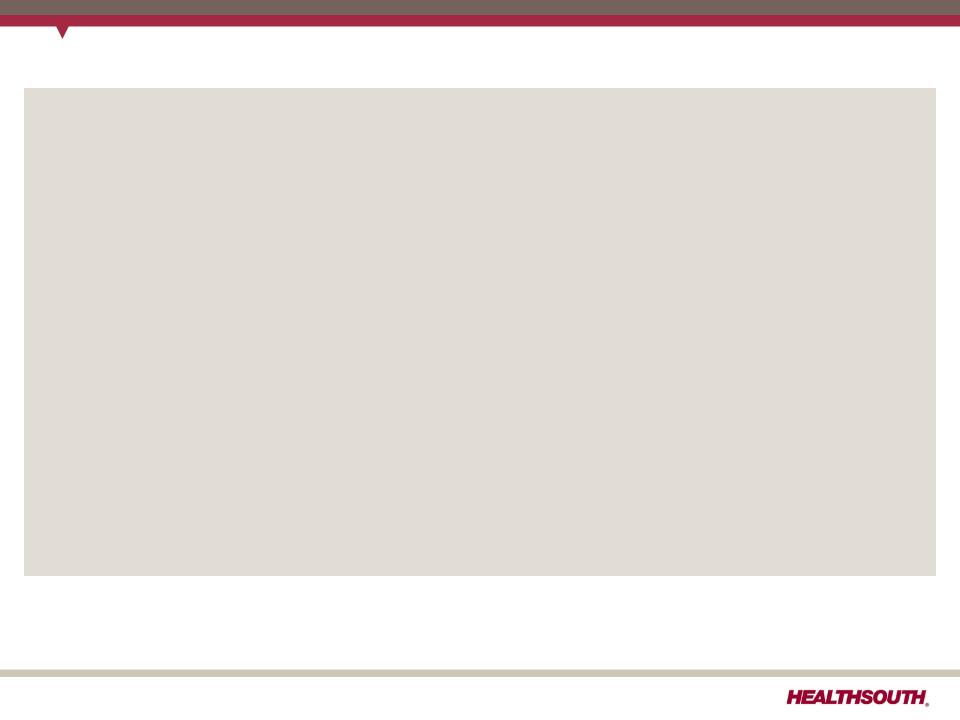
Income Tax Considerations
|
GAAP Considerations:
•Valuation allowance reduced at YE 2010 by approximately $825 million resulting in a
$736.6 million benefit to 2010 income tax provision. •As of 12/31/10, the Company had a remaining valuation allowance of approximately
$113 million, primarily related to state NOLs. Future Cash Tax Payments:
•Expects to pay approximately $6-8 million per year of income tax.
•Does not expect to pay significant federal income taxes for up to 10 years.
•HealthSouth is not currently subject to an annual use limitation (“AUL”) under Internal
Revenue Code Section 382 (“Section 382”). A “change of ownership,” as defined by Section 382, would subject us to an AUL, which is equal to the market capitalization of the Company at the time of the “change of ownership” multiplied by the long-term tax exempt rate. |
17
Exhibit 99.1
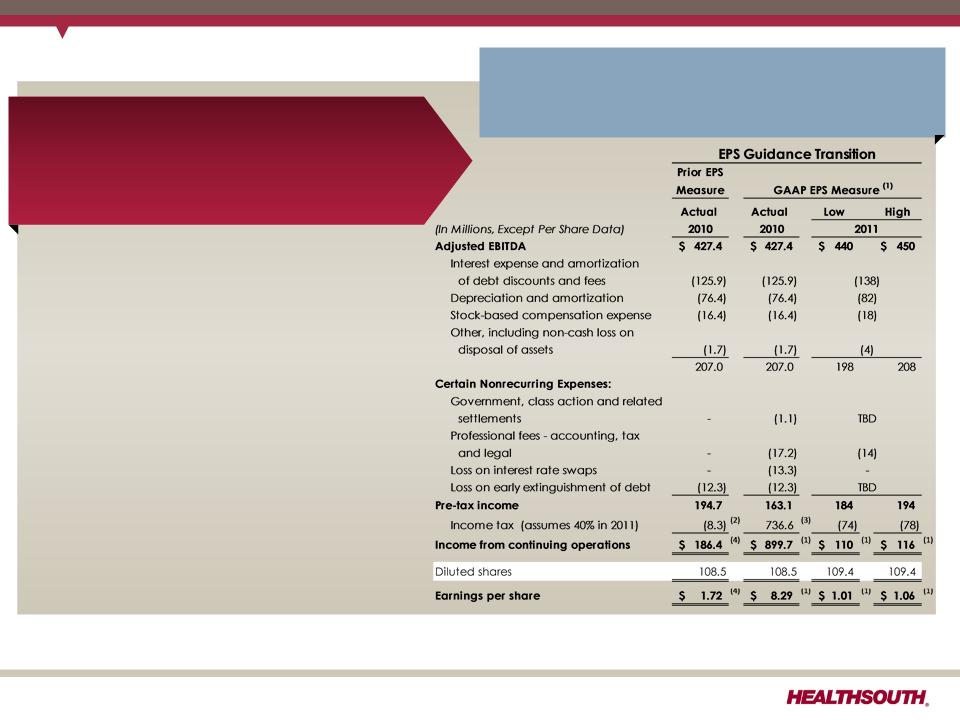
2011 Guidance - EPS
Diluted Earnings per Share from
Continuing Operations Attributable
to HealthSouth (1)
Continuing Operations Attributable
to HealthSouth (1)
$1.01 to $1.06
Considerations:
ü Assumes provision for income tax of 40%;
cash taxes expected to be $6-$8 million.
cash taxes expected to be $6-$8 million.
ü Guidance does not include any
repayment/refinancing of the 10.75%
repayment/refinancing of the 10.75%
senior notes callable in June 2011, which
would affect the following items:
• Interest expense which is currently
forecasted to be approximately $4
million per quarter higher in Q1, Q2, and
Q3 2011 vs. prior periods in 2010.
forecasted to be approximately $4
million per quarter higher in Q1, Q2, and
Q3 2011 vs. prior periods in 2010.
• Does not include “loss on early
extinguishment of debt” (non-cash)
extinguishment of debt” (non-cash)
• Depreciation is estimated to be higher
as a result of capital expenditures in
prior periods.
as a result of capital expenditures in
prior periods.
HealthSouth is transitioning EPS guidance to a
GAAP measure.
GAAP measure.
(1) Income from continuing operations attributable to HealthSouth
(2) Current period amounts in income tax provision; see slides 31 and 35
(3) Total income tax provision for full-year 2010, including the reversal of a substantial portion of the Company's valuation allowance against deferred tax assets.
(4) Adjusted income from continuing operations; see slides 31 and 35
18
Exhibit 99.1

• Volume:
– January and February 2011 exhibited strong discharge growth against easy comps from
Q1 2010.
Q1 2010.
– Full-year 2011 on track for 2.5% to 3.5 % discharge growth (comps become tougher as
the year progresses).
the year progresses).
• Pricing:
– Includes net Medicare price increase of approximately 2% effective Oct. 1, 2010.
– Comps will be impacted by the April 1, 2010, reduction (25 bps) of Medicare pricing
resulting from PPACA implementation.
resulting from PPACA implementation.
• Senior Notes Offering:
– HealthSouth completed a $120 million senior notes offering through a reopening of its
7.25% senior notes due 2018 and its 7.75% senior notes due 2022.
7.25% senior notes due 2018 and its 7.75% senior notes due 2022.
– Issued at a premium to par
– Net proceeds from the offering were $122.0 million.
§ $45 million of the net proceeds were utilized to pay down the revolving credit facility.
We intend to use the balance to redeem a portion of the 10.75% senior notes.
We intend to use the balance to redeem a portion of the 10.75% senior notes.
− Blended yield of add-on is approximately 7.0%
§ The impact on Q1 2011 interest expense is an increase of $0.5 million.
Q1 2011 Observations
19
Exhibit 99.1

(1) Reconciliation to GAAP provided on slides 29-35.
The HealthSouth Value Proposition
Poised for Growth
Financial Strength/Strong
Cash Flow Generation
Cash Flow Generation
Industry Leading Position
Attractive Healthcare Sector
20
Exhibit 99.1

Appendix
21
Exhibit 99.1
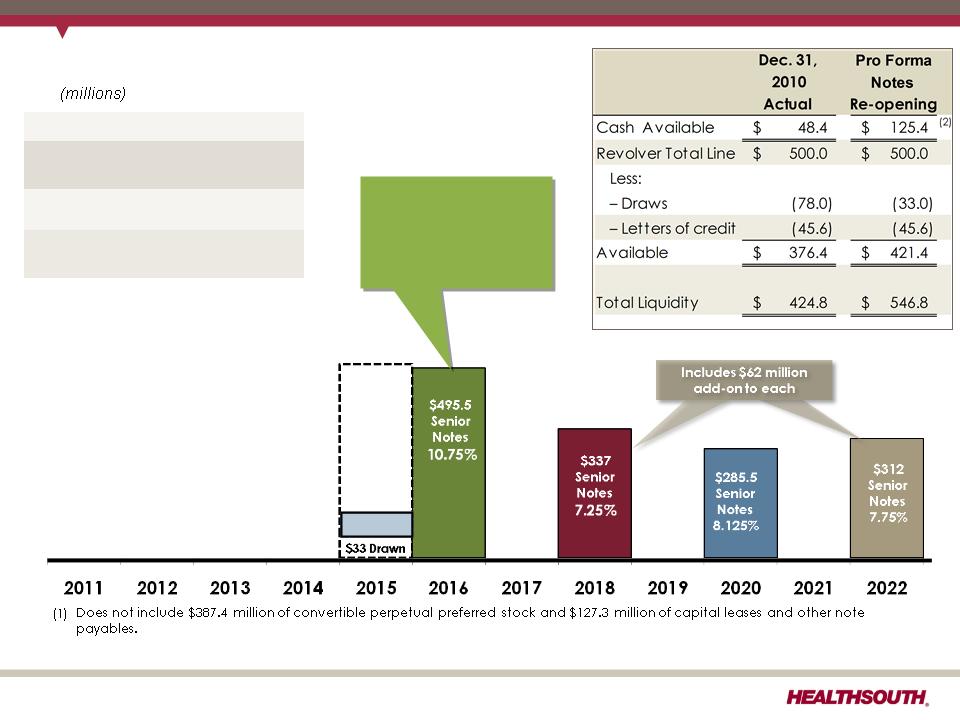
(2) Includes $77.0 million of the net proceeds from the notes reopening. We intend to use this portion of the net proceeds to redeem a
portion of the 10.75% senior notes.
portion of the 10.75% senior notes.
Debt Maturity Profile (1)
22
|
|
S&P
|
Moodys
|
|
Corporate
Rating |
B+
|
B1
|
|
Revolver Rating
|
BB
|
Ba1
|
|
Senior Notes
Rating |
B+
|
B2
|
Call schedule:
June 15, 2011 (price 105.375);
June 15, 2012 (price 103.583);
June 15, 2013 (price 101.792);
June 15, 2014 and thereafter
(price 100.000)
(price 100.000)
Pro Forma for Notes Re-opening
$46 LC
$500
Revolver
L+350
Exhibit 99.1

|
Sources
|
$ Million (1)
|
Assumed
Call Price (3) |
Annual
Cash Savings
|
|
Cash on hand
|
$100.0
|
105.375
|
$10.2
|
|
|
|
|
|
|
Revolving credit facility (LIBOR + 350 bps)(2)
|
$100.0
|
105.375
|
$6.4
|
|
|
|
|
|
|
New senior notes (assumed yield of 7.00%)
|
$100.0
|
105.375
|
$3.2
|
|
Accounting effect for early repayment/ refinancing :
|
|||
|
“Loss on early extinguishment of debt” = ~$8 million per $100 million of the 10.75% senior notes.
|
|||
|
|
|||
Options for Addressing the 10.75% Senior Notes
(millions)
(1) Illustrative only
(2) Assumes 3M LIBOR of 0.302%
(3) Call schedule: June 15, 2011 (price 105.375); June 15, 2012 (price 103.583); June 15, 2013 (price 101.792); June 15, 2014 and
thereafter (price 100.000)
thereafter (price 100.000)
We can utilize a number of sources to repay/refinance the 10.75% notes.
Illustration of Potential Interest Expense Reduction by Funding Source
23
Exhibit 99.1

Debt Schedule and Interest Expense
(1) The annualized interest expense does not reflect any anticipated pay down of the 10.75% or the impact of the re-opening of the
7.25% and the 7.75% senior notes.
7.25% and the 7.75% senior notes.
(2) On March 7, 2011, the Company closed on a public offering of $60 million in aggregate principal amount of its 7.25% senior
notes due 2018 at a public offering price of 103.25% of the principal amount and $60 million in aggregate principal amount of its
7.75% senior notes due 2022 at a public offering price of 103.50%.
notes due 2018 at a public offering price of 103.25% of the principal amount and $60 million in aggregate principal amount of its
7.75% senior notes due 2022 at a public offering price of 103.50%.
(3) Based on 2010 and 2009 Adjusted EBITDA of $427.4 million and $383.0 million, respectively; reconciliation to GAAP provided on
slides 29 and 31-35.
slides 29 and 31-35.
(4) Based on debt balances as of December 31, 2010 and assumes 3 month LIBOR of 0.302%.
24
Exhibit 99.1
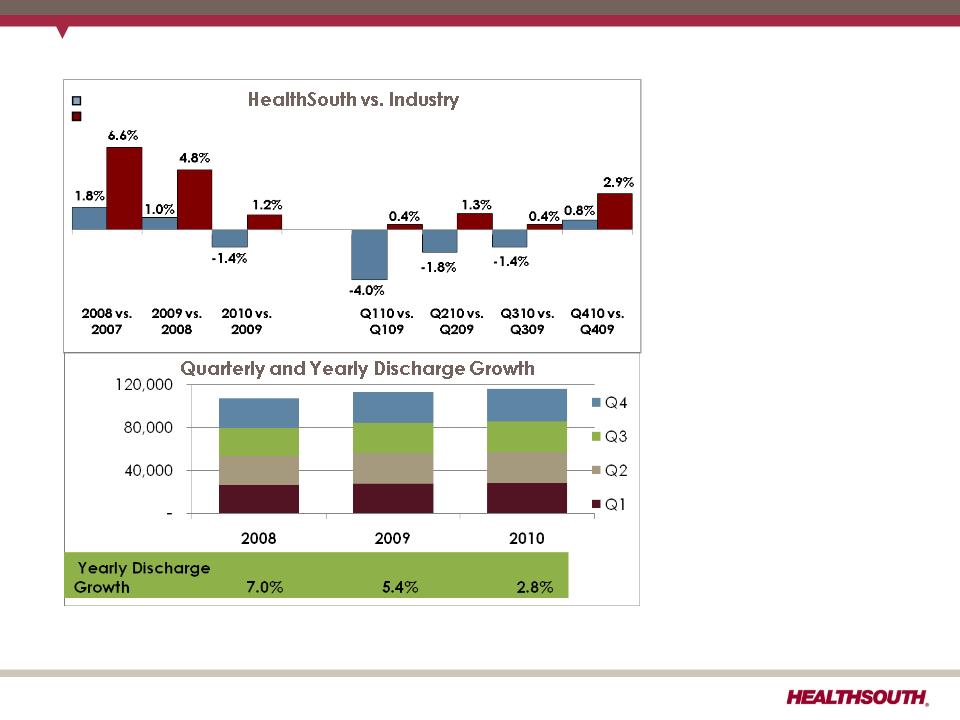
(1) Data provided by UDSMR, a data gathering and analysis organization for the rehabilitation industry; represents ~ 65-70% of industry,
including HealthSouth sites.
including HealthSouth sites.
(2) Includes consolidated HealthSouth inpatient rehabilitation hospitals and long-term acute care hospitals classified as same store during
that time period.
that time period.
Historic Discharge Growth vs. Industry
• HealthSouth’s
volume growth has
outpaced
competitors’.
volume growth has
outpaced
competitors’.
• TeamWorks =
standardized and
enhanced sales &
marketing
standardized and
enhanced sales &
marketing
• Bed additions will
help facilitate
continued organic
growth.
help facilitate
continued organic
growth.
UDS Industry Sites (1)
HLS Same Store (2)
10.7%
9.4%
5.6%
2.6%
4.6%
5.5%
5.8%
5.8%
5.3%
2.5%
2.2%
1.1%
25
Exhibit 99.1

Note: These numbers are program spending only and do not include beneficiary copayments.
Source: Centers for Medicare and Medicaid Services, Office of the Actuary (MedPAC June 2010 Data Book - Page 130), 2009 and 2010
Medicare Trustees Report
Medicare Trustees Report
Medicare Spending on Post-Acute Services
Skilled nursing
facilities 18.1%
facilities 18.1%
Home health
agencies 17.7%
agencies 17.7%
Inpatient
rehabilitation
hospitals 8.4%
Long-term acute
care hospitals 5.7%
26
2009
Medicare
Margin
Medicare
Margin
Post-Acute Settings
Inpatient rehabilitation
spending (% of total
Medicare spending)
spending (% of total
Medicare spending)
Exhibit 99.1
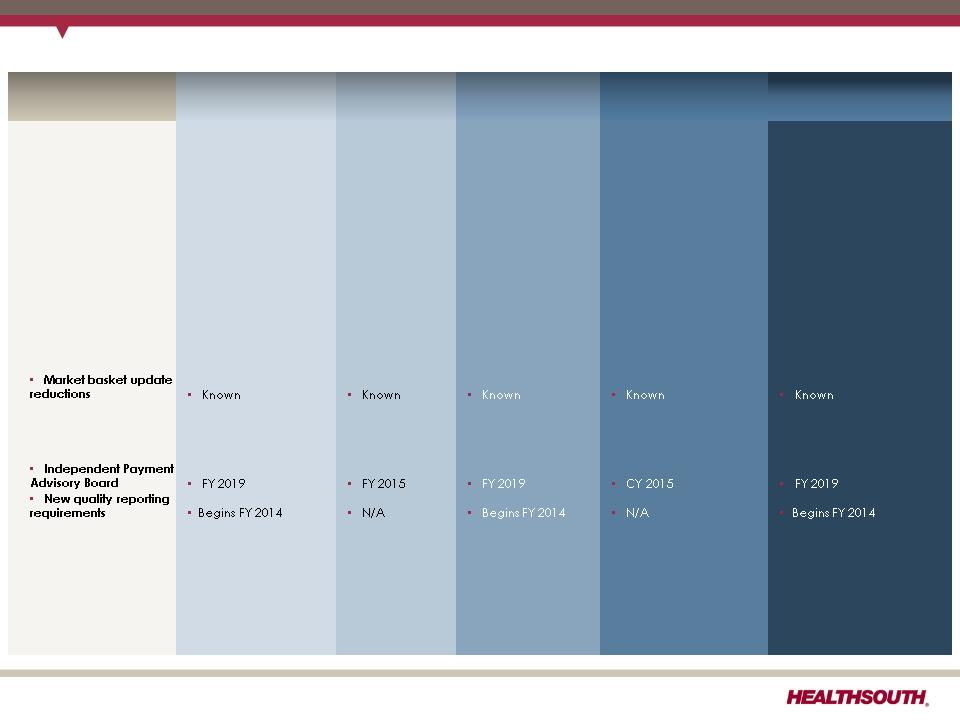
|
Future Regulatory Risk
|
Inpatient Rehabilitation
Facility |
Skilled Nursing
Facility |
Long-Term Acute
Care Hospital |
Home Health
|
Hospice
|
|
1. Re-basing payment
system |
No
|
Yes; RUGS IV and
MDS 3.0 implemented October 1, 2010 |
No
|
Yes; would be required
as part of PPACA starting in 2014 |
Yes: Required by PPACA
beginning in 2013; Modified wage index system being phased in over 7-year period beginning in FY 2010 |
|
2. Major outlier payment
adjustments |
No
|
No
|
Yes; will occur when
MMSEA relief expires (short stay outliers) |
Yes; 10% cap per agency;
2.5% taken out of outlier
pool (per PPACA) |
No
|
|
3. Upcoding adjustments
|
No
|
No
|
Yes; occurring in FY
2011 |
Yes; occurring in CY 2011 (
-3.79%), and potential further reduction 2012 |
No
|
|
4. Patient criteria
|
No; 60% Rule
already in place
|
No
|
Study dictated as
part of MMSEA; Industry developing criteria |
PPACA requires a patient -
physician “face-to-face” encounter; new therapy coverage
|
No
|
|
5. Healthcare Reform
|
|
|
|
|
|
|
• Productivity
adjustments |
• Begins FY 2012
|
• Begins FY 2012
|
• Begins FY 2012
|
• Begins 2015
|
• Begins 2013
|
|
• Bundling pilot
established |
• By 2013
|
• By 2013
|
• By 2013
|
• By 2013
|
• N/A
|
|
• Value based
purchasing |
• Pilot begins 2016
|
• Post 2012
|
• Pilot begins 2016
|
• Post 2012
|
• Pilot begins 2016
|
|
•Hospital Acquired
Infections |
• Post 2012
|
• Post 2012
|
• Post 2012
|
• N/A
|
•N/A
|
|
6. Other
|
N/A
|
Forecast error
being implemented in FY 2011 |
25% Rule regulatory
relief expires in 2012/2013; prohibition on new LTCHs through 2012 |
Limits on transfer
of ownership |
MedPac recommending
overhaul of payment system methodology in FY 2013 |
Post-Acute Regulatory Risks
Sources: Healthcare Reform Bill (PPACA, HERA),CMS Regulatory published rules and MMSEA
27
Exhibit 99.1

CMS Fiscal Year 2011 IRF Rate Setting File Analysis
Notes:
(1) All data provided was filtered and compiled from the Centers for Medicare and
Medicaid Services (CMS) Fiscal Year 2011 IRF rate setting Final Rule file found at
http://www.cms.hhs.gov/InpatientRehabFacPPS/07_DataFiles.asp#TopOfPage. The
data presented was developed entirely by CMS and is based on its definitions
which are different in form and substance from the criteria HealthSouth uses for
external reporting purposes. Because CMS does not provide its detailed
methodology, HealthSouth is not able to reconstruct the CMS projections or the
calculation.
Medicaid Services (CMS) Fiscal Year 2011 IRF rate setting Final Rule file found at
http://www.cms.hhs.gov/InpatientRehabFacPPS/07_DataFiles.asp#TopOfPage. The
data presented was developed entirely by CMS and is based on its definitions
which are different in form and substance from the criteria HealthSouth uses for
external reporting purposes. Because CMS does not provide its detailed
methodology, HealthSouth is not able to reconstruct the CMS projections or the
calculation.
(2) The CMS file contains data for each of the 1,171 inpatient rehabilitation facilities
used to estimate the policy updates for the FY 2011 IRF-PPS Final Rule. Most of the
data represents historical information from the CMS fiscal year 2009 period and
does not reflect the same HealthSouth hospitals in operation today. The data
presented was separated into three categories: Freestanding, Units, and
HealthSouth. HealthSouth is a subset of Freestanding and the Total.
used to estimate the policy updates for the FY 2011 IRF-PPS Final Rule. Most of the
data represents historical information from the CMS fiscal year 2009 period and
does not reflect the same HealthSouth hospitals in operation today. The data
presented was separated into three categories: Freestanding, Units, and
HealthSouth. HealthSouth is a subset of Freestanding and the Total.
28
Exhibit 99.1

(1) Notes on page 35.
Net Cash Provided by Operating Activities
29
Exhibit 99.1

Adjusted Free Cash Flow
(1) Q4 2010 and full-year 2010 working capital benefited from a shift in timing of interest payments related to the refinancing in Q4 2010.
(2) Q4 2010 and full-year 2010 were negatively affected by the $6.9 million unwind fee related to the termination of two forward-starting
interest rate swaps, which is included in cash provided by operating activities and not included in the net settlements on interest rate
swaps.
interest rate swaps, which is included in cash provided by operating activities and not included in the net settlements on interest rate
swaps.
30
Exhibit 99.1

Reconciliation of Net Income to Adjusted Income from Continuing Operations and
Adjusted EBITDA (1) (3) (4)
Adjusted EBITDA (1) (3) (4)
(1) (2) (3) (4) - Notes on page 35.
31
Exhibit 99.1

(1) (2) (3) (4) - Notes on page 35.
32
Exhibit 99.1

(1) (2) (3) (4) - Notes on page 35.
33
Exhibit 99.1

34
(1) (2) (3) (4) - Notes on page 35.
Exhibit 99.1
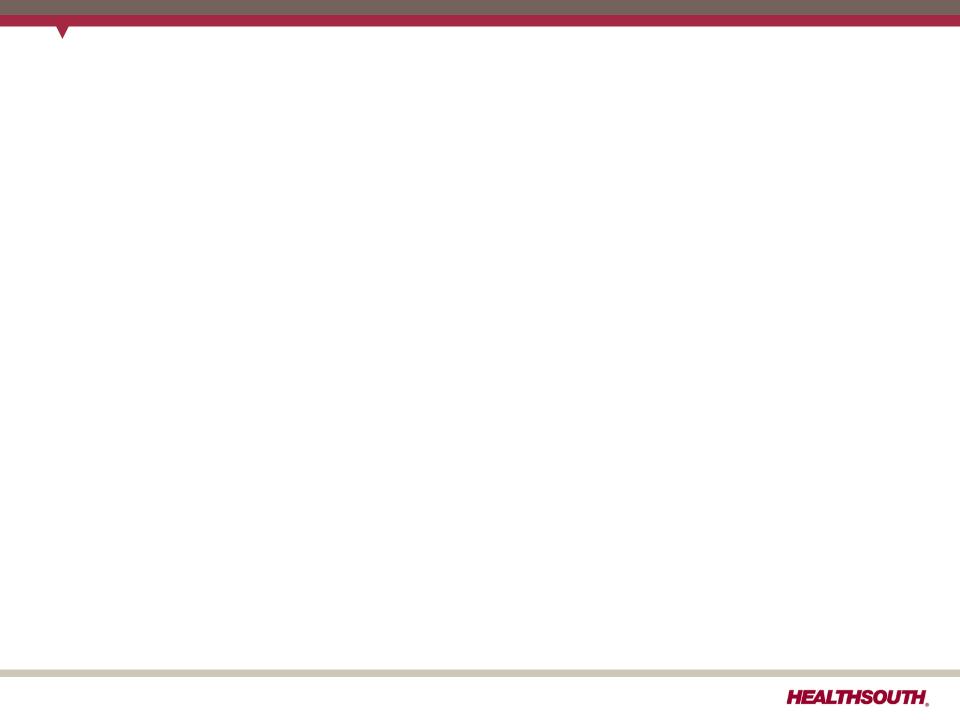
Reconciliation Notes
1. Adjusted income from continuing operations and Adjusted EBITDA are non-GAAP
financial measures. The Company’s leverage ratio (total consolidated debt to
Adjusted EBITDA for the trailing four quarters) is, likewise, a non-GAAP financial
measure. Management and some members of the investment community utilize
adjusted income from continuing operations as a financial measure and Adjusted
EBITDA and the leverage ratio as liquidity measures on an ongoing basis. These
measures are not recognized in accordance with GAAP and should not be viewed as
an alternative to GAAP measures of performance or liquidity. In evaluating these
adjusted measures, the reader should be aware that in the future HealthSouth may
incur expenses similar to the adjustments set forth above.
financial measures. The Company’s leverage ratio (total consolidated debt to
Adjusted EBITDA for the trailing four quarters) is, likewise, a non-GAAP financial
measure. Management and some members of the investment community utilize
adjusted income from continuing operations as a financial measure and Adjusted
EBITDA and the leverage ratio as liquidity measures on an ongoing basis. These
measures are not recognized in accordance with GAAP and should not be viewed as
an alternative to GAAP measures of performance or liquidity. In evaluating these
adjusted measures, the reader should be aware that in the future HealthSouth may
incur expenses similar to the adjustments set forth above.
2. Per share amounts for each period presented are based on basic weighted average
common shares outstanding for all amounts except adjusted income from continuing
operations per diluted share, which is based on diluted weighted average shares
outstanding. The difference in shares between the basic and diluted shares
outstanding is primarily related to our convertible perpetual preferred stock.
common shares outstanding for all amounts except adjusted income from continuing
operations per diluted share, which is based on diluted weighted average shares
outstanding. The difference in shares between the basic and diluted shares
outstanding is primarily related to our convertible perpetual preferred stock.
3. Adjusted income from continuing operations per diluted share and Adjusted EBITDA
are two components of our historical guidance.
are two components of our historical guidance.
4. The Company’s credit agreement allows certain other items to be added to arrive at
Adjusted EBITDA, and there may be certain other deductions required.
Adjusted EBITDA, and there may be certain other deductions required.
35
Exhibit 99.1
